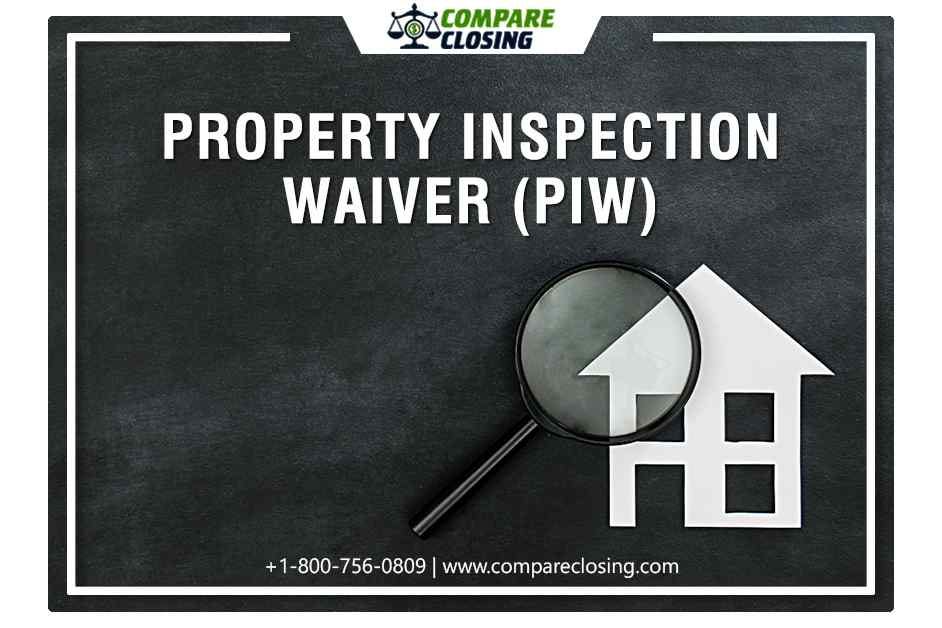
About Property Inspection Waiver (PIW)
When a mortgage is eligible for an appraisal waiver, meaning, the loan can be approved without a full home appraisal report then it is called a property inspection waiver (PIW).
The two government-sponsored enterprises, Fannie Mae and Freddie Mac support the mortgage market and allow lenders to use existing data to originate the mortgage without asking for a real estate appraiser’s feedback are PIW.
A PIW Mortgage Qualifying Method
These appraisal waivers are offered only on conventional mortgages if a borrower is buying or refinancing a home then there are a few government mortgage refinance programs that don’t demand appraisals.
With a property inspection waiver, you pace up the loan process and save almost $300 or $400 which is a usual cost for a full home appraisal report.
Depending on whether you’re applying for a loan backed by Fannie Mae or Freddie Mac your appraisal waiver will change.
- PIW options are offered by Fannie Mae on their loans approved through the Desktop Underwriting (DU) automated underwriting system.
- Automated collateral evaluation (ACE) appraisal waiver of Freddie Mac’s is offered through the Loan Product Advisor automated underwriting system.
The most important factor to qualify for an appraisal waiver is your loan to value (LTV) ratio which is a measure of how much of your home’s value you’re borrowing.
Any way to qualify for a PIW, the borrower would either need to make a down payment of at least 20% on a home purchase or should have equity in their home of at least 10% on limited cash-out refinance.
If borrowers want to get extra money above what they currently owe with a cash-out refinance then they need more equity for an appraisal waiver.
As mentioned earlier depending on various factors the eligibility for PIW will change.
Property type: If the property is of a single unit or a condominium
Purchase type: Principal residences and second homes up to 80% of the home’s value
Refinance type
- Limited cash-out refinances:
Up to 90% LTV for primary residences and second home
Up to 70% LTV for investment properties
- Cash-out refinances:
Up to 70% of the value of primary residences
Up to 60% of the value of second homes and investment properties
Understanding Mortgage Appraisals
To determine how much your home is worth a home appraisal is needed. A licensed real estate appraiser conducts an appraisal and provides a neutral assessment of the home’s value.
An inspection is performed by the appraiser of the home’s interior and exterior state, design, and features to find out its value compared to recent home sales in the area.
During the homebuying process, you’ll get an appraisal and it is reviewed by lenders to make sure that the purchase price is correct and is used to calculate how much of the home’s value can you borrow.
A borrower may also need an appraisal for a mortgage to refinance so the lender can confirm your value is high enough to replace your current mortgage with a new one.
Pros and Cons of getting a Property Inspection Waiver
Pros:
- A borrower need not spend money on the cost of the appraisal
- You won’t have to go through the waiting period for the appraisal to be completed
- If you’re refinancing you need not deck up your home for an interior evaluation
- With a PIW you may be able to close on a purchase or refinance loan much faster
Cons:
- You will miss out on a third-party opinion of your home’s value
- You’ll have to depend on data provided by previous appraisers which may not be accurate now
- You could be borrowing money on a house that’s priced much higher than its actual market value
- You will be lacking an up-to-date assessment of your home’s condition
Things to Know About PIW
You may still request a full appraisal even if you’re eligible for an appraisal waiver. Similarly just because it’s offered to you, you’re not required to accept a PIW or ACE.
If you have concerns regarding the value of the home you’re buying, then an appraisal report from a licensed real estate appraiser would be worth the extra expense to prevent you from paying excessively for a home.
For an extensive look at the home’s condition right from the roof to the foundation, you should always get a property inspection done.
Other PIW Mortgage Programs
Homeowners can take advantage of streamlined refinance programs if they have loans backed by VA, FHA, and USDA these loans usually don’t require an appraisal.
Neither do these programs require any proof of income which is an added bonus.
Conclusion
An appraisal waiver is an offer to forgo the appraisal for eligible transactions.
For properties that are identified by the Federal Housing Finance Agency (FHFA) in high-needs rural locations, Fannie Mae offers a PIW mortgage.
To qualify for a PIW mortgage the property must be a primary residence with an LTV ratio up to 97%.
Some lower-income borrowers may be eligible provided they meet lending requirements for a PIW mortgage up to a 105% combined LTV ratio.
According to the Consumer Financial Protection Bureau, if a borrower decides to obtain an appraisal, their lender must provide a copy to them at least 3 days before the closing.
The borrower is not charged while requesting a copy of the original report.
Comments
Post a Comment